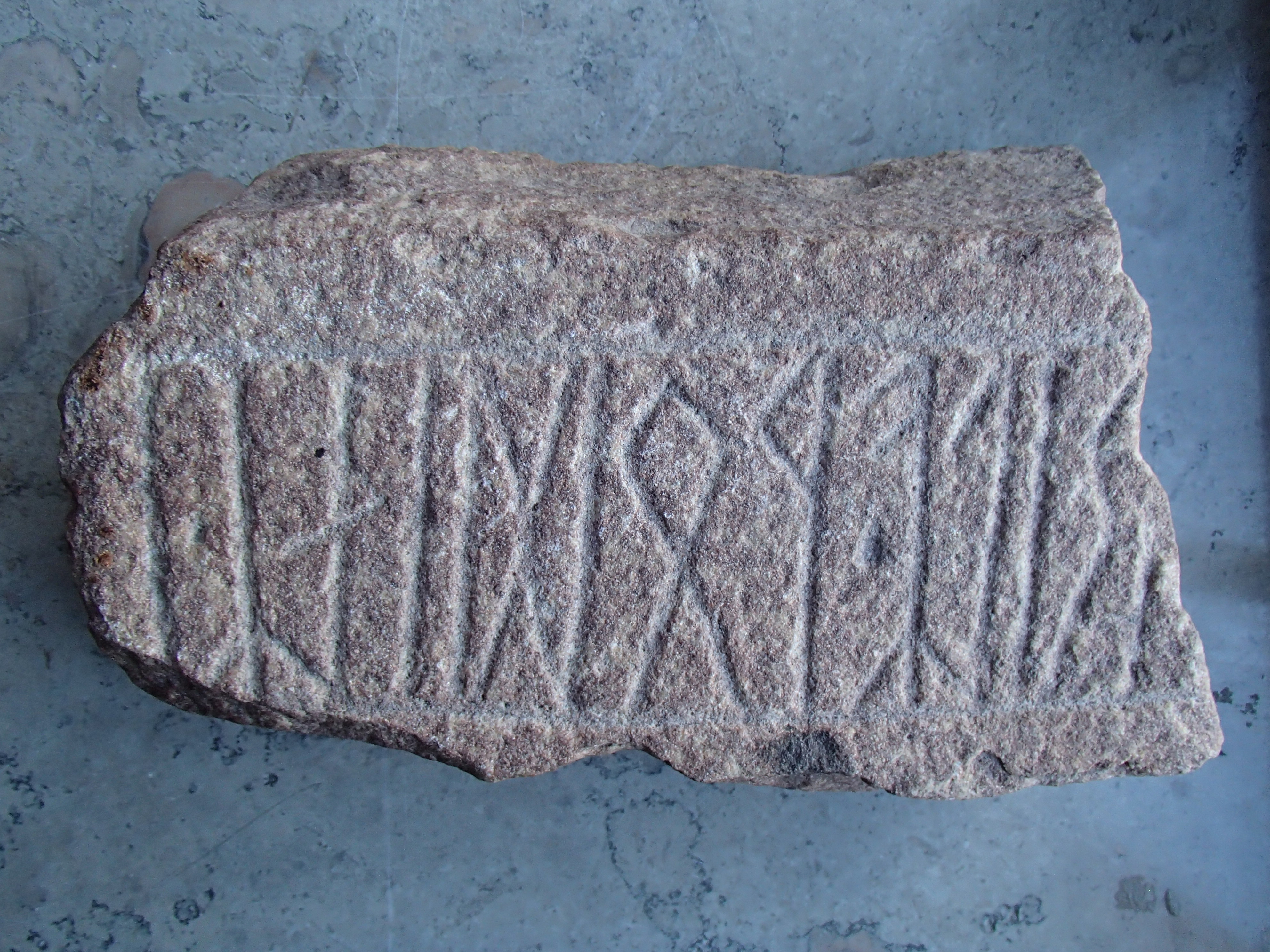Erilaz on:
[Wikipedia]
[Google]
[Amazon]
''Erilaz'' or ''Erilaʀ'' is a Migration period
Kiel Rune Project
/ref> that bears the inscription: ::'' €¦' ::'' €¦' Which is interpreted as "I, the earl of Ä€sugÄ«salaz, am called Muha," followed by some sort of battle cry or chant ("gagaga"). Ä€sugÄ«salaz contains '' ansu-'', "god", and ''gÄ«salaz'', "pledge". ''Muha'' may either be a personal name, or a word meaning "retainer" or similar. The runes of ''gagaga'' are displayed as a row of three bindrunes based on the X-shape of the ''g'' rune with side-twigs attached to its extremities for the ''a''. A similar sequence ''gægogæ'' is found on the
 *
*
book review
Wortmaterial der Runeninschriften nach Wortklassen
Historical runic magic Elder Futhark inscriptions Proto-Norse language
Proto-Norse
Proto-Norse (also called Ancient Nordic, Ancient Scandinavian, Ancient Norse, Primitive Norse, Proto-Nordic, Proto-Scandinavian and Proto-North Germanic) was an Indo-European language spoken in Scandinavia that is thought to have evolved as ...
word attested on various Elder Futhark inscriptions, which has often been interpreted to mean " magician" or "rune master",* viz. one who is capable of writing runes
Runes are the letters in a set of related alphabets known as runic alphabets native to the Germanic peoples. Runes were used to write various Germanic languages (with some exceptions) before they adopted the Latin alphabet, and for specialised ...
to magical effect. However, as Mees (2003) has shown, the word is an ablaut variant of earl
Earl () is a rank of the nobility in the United Kingdom. The title originates in the Old English word ''eorl'', meaning "a man of noble birth or rank". The word is cognate with the Scandinavian form ''jarl'', and meant " chieftain", particu ...
, and is also thought to be linguistically related to the name of the tribe of the Heruli, so it is probably merely an old Germanic military title (see etymology below).
Etymology
This word is likeliest theProto-Germanic
Proto-Germanic (abbreviated PGmc; also called Common Germanic) is the reconstructed proto-language of the Germanic branch of the Indo-European languages.
Proto-Germanic eventually developed from pre-Proto-Germanic into three Germanic br ...
ancestor of Anglo-Saxon
The Anglo-Saxons were a cultural group who inhabited England in the Early Middle Ages. They traced their origins to settlers who came to Britain from mainland Europe in the 5th century. However, the ethnogenesis of the Anglo-Saxons happened wit ...
''eorl'' (Modern English ''earl'') and its relatives, meaning "man, warrior, noble". The word ''erilaz'' is likely a derivative of *''erÇ'' sb.f. "fight, battle", thus the interpretation "one who fights, warrior", though it has also been connected to *''arĂ´'' sb.m. "eagle".
Historical instances:
*Latin: Heruli (dating from around 250 AD onwards)
*Greek: Eruloi (dating from around 250 AD onwards)
*Runic: Erilaz (dating from around 200 AD - 400 AD)
Inscriptions
Lindholm "amulet"
The Lindholm "amulet" ( DR 261 $U) is a bone piece found in SkĂĄne, dated to the 2nd to 4th centuries. The inscription contains the word ''Erilaz''.Funen shaft
The Kragehul I (DR 196 U) spear-shaft found inFunen
Funen ( da, Fyn, ), with an area of , is the third-largest island of Denmark, after Zealand and Vendsyssel-Thy. It is the 165th-largest island in the world. It is located in the central part of the country and has a population of 469,947 as o ...
/ref> that bears the inscription: ::'' €¦' ::'' €¦' Which is interpreted as "I, the earl of Ä€sugÄ«salaz, am called Muha," followed by some sort of battle cry or chant ("gagaga"). Ä€sugÄ«salaz contains '' ansu-'', "god", and ''gÄ«salaz'', "pledge". ''Muha'' may either be a personal name, or a word meaning "retainer" or similar. The runes of ''gagaga'' are displayed as a row of three bindrunes based on the X-shape of the ''g'' rune with side-twigs attached to its extremities for the ''a''. A similar sequence ''gægogæ'' is found on the
Undley bracteate
The Undley bracteate is a 5th-century bracteate found in Undley Common, near Lakenheath, Suffolk. It bears the earliest known inscription that can be argued to be in Anglo-Frisian Futhorc (as opposed to Common Germanic Elder Futhark).
The ima ...
.
Other items
 *
*Strängnäs stone
The Strängnäs stone ( sv, Strängnässtenen), or runic inscription Sö Fv2011;307 (formerly Sö ALLHSÖDERM;77), is a runestone inscribed with runes written in Proto-Norse using the Elder Futhark alphabet. It was discovered in 1962, when a st ...
(probably authentic) …rila͡z
* Bracteates Eskatorp-F and Väsby-F have e rilaz = "I ma Herulian"
*Bratsberg clasp: ekerilaz
*Veblungsnes:ekirilazwiwila
*Rosseland (N KJ69 U): ekwagigazirilaz
* Järsberg Runestone (Vr 1): ekerilaz
*By (N KJ71 U): ekirilaz
*The Etelheim clasp has mkmrlawrta read as ek erla wrta "I, Erla, wrote this"; Runic e and m are similar to each other.
Notes
References
* Mees, B. (2003). "Runic 'erilaR'", ''North-Western European Language Evolution (NOWELE)'', 42:41-68. * Orel, Vladimir (2003). ''A Handbook of Germanic Etymology''. Leiden: Brill. pg. 205. . * Plowright, S. (2006). ''The Rune Primer'', Lulu Press. {{ISBN, 1-84728-246-6book review
External links
Wortmaterial der Runeninschriften nach Wortklassen
Historical runic magic Elder Futhark inscriptions Proto-Norse language